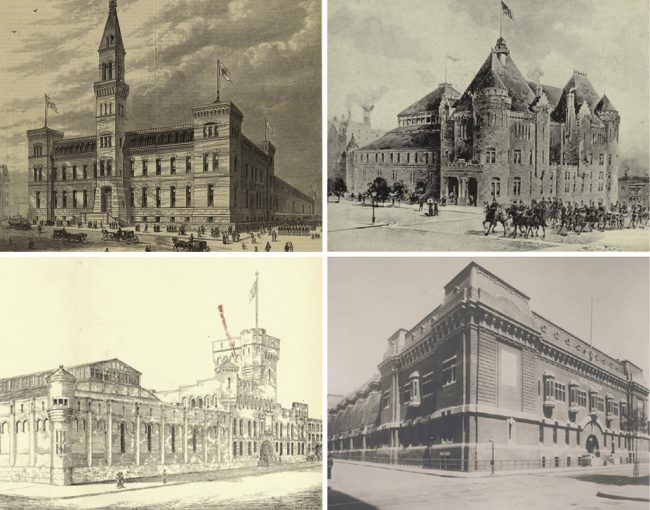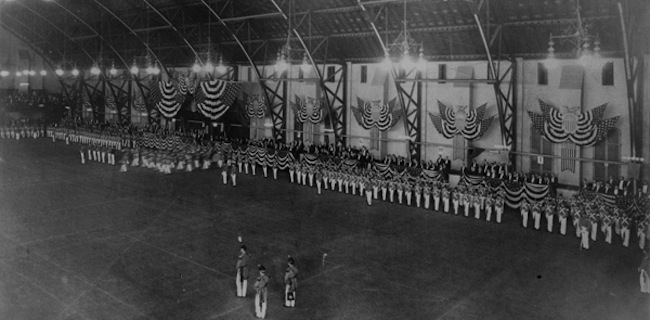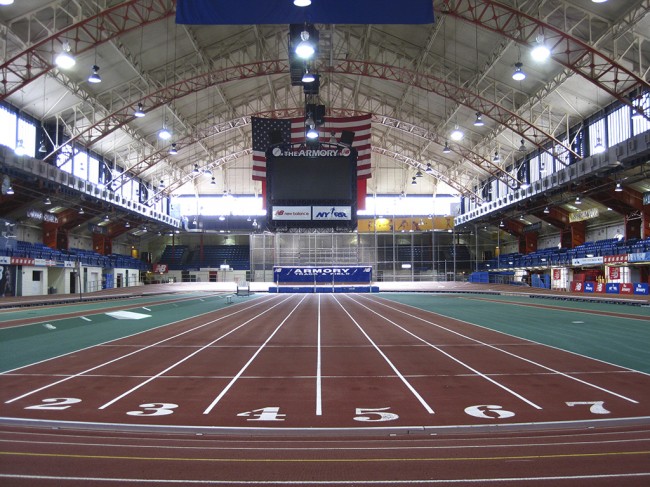
We are celebrating 15 years — and counting — of stories that are deeply researched and deeply felt, that build a historical record of what the city has been.
We are celebrating 15 years — and counting — of stories that are deeply researched and deeply felt, that build a historical record of what the city has been.
On September 28th, The Architectural League will host its annual Beaux Arts Ball in the 69th Regiment Armory on Lexington Avenue and 25th Street. While each Beaux Arts Ball takes inspiration from and responds to the building where it is held — such as last year’s party in the Williamsburgh Savings Bank Tower in Fort Greene or the previous year’s in the Brooklyn Army Terminal in Sunset Park — this year, the event’s bespoke installation (an environment designed by SITU STUDIO and an interactive performance organized by Processional Arts Workshop) is also inspired by the historic exhibition that took place in the Armory one hundred years ago. “The Armory Show” of 1913 introduced American audiences to vanguard styles of visual art originating in Europe, including Cubism, Fauvism, Futurism, and modernism more broadly.
But there’s another cultural tradition to which armories such as the 69th Regiment’s testify: that of the National Guard. This legacy is not only one of military history, but also of urban history. While the concept of the citizen-soldier may evoke contradictory images — the colonial-era-farmer-cum-militiaman, the draft, an active reserve corps — it should also remind us of the National Guard’s civic role in the streets and neighborhoods of our cities. That role, along with the technical program requirements of arsenals and armories, significantly informed the architecture of the National Guard’s institutional facilities and the ways those buildings are folded into the American urban landscape.

Clockwise from top left: Armories of the 7th, 71st, 12th, and 69th Regiments in New York City | Images courtesy of the New York Public Library and New York State Military Museum
The National Guard in the American City
In the first two decades of the 20th century, New York City saw the construction of seven large armories in Manhattan, Brooklyn, and the Bronx. Despite this growth in facilities, the National Guard was in the midst of a transition away from what had been a long-ascendant position within the armed forces.
Only in the 20th century did a federally controlled corps of professional soldiers become the predominant component of the military system. For the first three centuries of American history, decentralized and state-controlled militias of citizen-soldiers were the nation’s primary resource for civil defense and response to civil unrest. In her comprehensive illustrated history, New York’s Historic Armories, Nancy Todd characterizes the three-part functions of each of these militias in the decades leading up to the Civil War: “First and foremost, it was a military body charged with ensuring both domestic and international peace; second, it was a civic entity whose responsibilities included appearing at both somber and festive public events; finally, it was an elite fraternal organization for members of New York’s middle and upper classes.”[1]

Drill Hall of the 7th Regiment Armory on Park Avenue | Courtesy of the New York State Military Museum
Domestic unrest was a major concern during the United States’ often violent transformation into an industrialized and increasingly socially stratified nation. Riots and strikes became bloodier as the chasms between rich and poor, native and immigrant, and capital and labor all widened in the Gilded Age. These conflicts were especially intense in rapidly growing urban centers, where slums and sweatshops festered alongside burgeoning entrepreneurialism and the development of influential institutions in culture, finance, and labor relations. Particularly in New York, with the fledgling municipal police force unable to keep the peace, the National Guard defended the status quo by suppressing demonstrators and ending riots, prompting one commentator, in an 1877 issue of Harper’s Weekly, to praise the troops as “the flower of American citizen soldiery, [who] have by their attitude and conduct earned the grateful respect of all good citizens everywhere in the country.”[2]
The National Guard’s more civic functions included participating in all manner of public events, marching in parades or attending county fairs in uniform. And the private, social aspects of various regiments — formal occasions like concerts or balls as well as informal clubhouse activities and sports — were in some cases enhanced by a shared cultural background among guardsmen. For example, the 69th Regiment was originally composed of first- and second-generation Irish-Americans.[3]
After the success of the US Navy in the Spanish-American War, President Theodore Roosevelt signed the Militia Act in 1903 (also known as the Dick Act), which recognized the federal, standing army as primary in the military establishment and defined the National Guard’s combat role as a reserve force, able to be called into action by the commander-in-chief.[4] This shift served to emphasize each National Guard regiment’s civic and social role in its community.
This civic purpose was announced through the architecture of National Guard facilities. Sited at the center of neighborhoods, woven into the fabric of streets, armories reminded passersby that the government and the military were a present and permanent part of their communities.
The 69th Regiment Armory
In 1903, the same year as the Dick Act became law, the firm of Hunt & Hunt won the architecture competition for the 69th Regiment Armory on Lexington Avenue. A number of high profile architects of the period had entered the competition, including Robert W. Gibson, Grosvenor Atterbury, Henry J. Hardenbergh, and George B. Post (one of the first presidents of The Architectural League).
Armories of the period had three primary functions: they were simultaneously “military facilities, clubhouses and public monuments.”[5] Their program requirements included the administrative headquarters of each regiment, the warehousing of munitions, and interior spaces large enough to accommodate military exercises and drills, which had previously taken place in public squares and markets. (Until 1880, the 69th Regiment ran drills and exercises alongside the purveyors of Essex Street. It then moved to the Tompkins Market and Armory on 3rd Avenue and 6th Street, a mixed-use building from 1857 with a drill hall and offices on the upper floors and a meat market at street level, developed by a consortium of butchers and militiamen.)[6]
The construction of these interior drill halls — tens of thousands of square feet in size — required state-of-the-art engineering techniques such as exposed steel truss work that recalled the design of both train sheds and exhibition halls. But while the need for a massive unobstructed space was the main driver of an armory’s design, most late-19th century armories emphasized the administrative building as the public face of the fortress-like facility. Hunt & Hunt chose not to hide the function of the facility behind the castle-like turrets and parapets predominant among its predecessors.[7] As critic Montgomery Schuyler put it in Architectural Record after its unveiling in 1906, the building was “noteworthy by the absence of the conventions of military architecture,” and “a modern armory on modern lines.”[8] For Schuyler, Hunt & Hunt’s design was less evocative of an ornate medieval fortress than an elegant Beaux Arts train depot with a symmetrical façade, a building that communicated clearly what was going on within its brick walls.
From Drill Hall to Civic Space
Like most armories, the 69th Regiment Armory was sometimes made available as a venue for large-scale events unaffiliated with the National Guard. In a time before convention centers and kunsthalles, the scale and grandeur of these buildings were enticing to local businesses hosting Christmas parties, sporting associations hosting track races[9], and the occasional art organization hosting an exhibition.
The United States had witnessed unprecedented economic and urban growth in the years leading up to 1913, enabled by major advances in transportation and communications technology that made the world seem smaller and more interconnected. While rapid change was fuelling creative revolutions in Europe, a young generation of American artists were worried that America’s cultural interests had become antiquated and provincial. This concern motivated the formation of the Association of American Painters and Sculptors in 1911, which promptly went about mounting an ambitious exhibit to introduce American artists to contemporary European art — works on display included controversial, now-iconic works by Brancusi, Duchamp, and Matisse — and to situate this new vanguard of abstract paintings and sculptures in a lineage dating back to the Renaissance. In so doing, the organizers hoped to legitimize and create a market for their own artwork and that of a new generation of American artists. The show, which attracted half a million visitors by the end of its three-city tour, would end up strongly influencing how contemporary art was received and produced in the United States from that point on.
Critical reception ranged from the horrified to the exhilarated. The European painters received the most attention, with Duchamp’s Nude Descending a Staircase becoming a particular focal point of derision, rapture, and increased attendance at the show. The Evening Sun described the painting in a number of ways: “The Rude Descending a Staircase,” “A lot of disguised golf clubs and hangs,” “an assortment of half-made leather saddles,” “an orderly heap of broken violins,” “an academic painting of an artichoke,” “a staircase descending a nude.” Bolton Brown of The New York Times extended his criticism to the lot of modern artists with work on display, writing that “the formula for their production is to compel a painter to use only two per cent of either his knowledge or his taste.” And none other than former president Theodore Roosevelt felt compelled to comment on the show:
Probably in any reform movement, any progressive movement, in any field of life, the penalty for avoiding the commonplace is a liability to extravagance… In this recent art exhibition the lunatic fringe was fully in evidence, especially in the rooms devoted to the Cubists and the Futurists, or Near-Impressionists. I am not entirely certain which of the two-latter terms should be used in connection with some of the various pictures and representations of plastic art — and, frankly, it is not of the least consequence. The Cubists are entitled to the serious attention of all who find enjoyment in the colored puzzle pictures of the Sunday newspapers. Of course there is no reason for choosing the cube as a symbol… There is no reason why people should not call themselves Cubists, or Octagonists, or Parallelopipedonists, or Knights of the Isosceles Triangle, or Brothers of the Cosine, if they so desire; as expressing anything serious and permanent, one term is as fatuous as another.[10]
Despite President Roosevelt’s dismissal of Cubists and Futurists, he began his opinion piece by calling the show “noteworthy” and thanking its organizers for giving “the public a chance to see what has recently been going on abroad…the art forces which of late have been at work in Europe, forces which cannot be ignored.” This assessment was shared by the art critics who championed the exhibition’s urgent call for a revival of art culture in the United States. The New York Sun called it “sensational…wrought something very like a miracle.” Critic J.N. Laurvik took the art on display as a sign that “Realism is receiving its death blow and individualism is asserting itself once more. And the new art which is arousing so much discord and opposition is an expression of this self-assertion, of this effort of the individual to emerge from the mass.”
“The International Exhibition of Modern Art,” (which came to be known as “The Armory Show” after its famous venue on Lexington) was hardly the only harbinger of modernity and change that hit New York in 1913. The Woolworth Building, the tallest skyscraper the world had ever seen, and Grand Central Terminal both opened that year. In March, women from around the country were joining hands to march on Washington in the Women’s Suffrage Parade, held the day before Woodrow Wilson’s inauguration.[11] A six-month silk mill workers’ strike in Paterson, New Jersey, prompted sympathetic artists in Greenwich Village to stage a re-enactment of strike events that played to a crowd of thousands in Madison Square Garden that summer.[12]
The Paterson silk strike was one of a number of industrial actions of the period, particularly in the garment and textile industries. But while labor unrest continued to disturb productivity in the opening decades of the 20th century, it no longer disturbed the peace in quite the same way as it had in the 1870s and ’80s. The public at large didn’t view strikes as an existential threat to the capitalist economy in quite the same way anymore, and many of the most urgent demands of organized labor were addressed through public policies like the eight-hour workday, minimum wage laws, and tenement reforms. On the home front, then — with the working classes effectively silenced and state police forces increasingly professionalized — the popular conception of the National Guard as a combat force began to subside.
Nonetheless, National Guard units continued to build armories into the middle of the century as they evolved into “proactive community organizations in their hometowns and cities, and their armories began to function as civic centers, particularly after World War I… Many National Guard units quickly became pivotal public entities whose interests in community stability and well-being were equal to those of local politicians, businessmen and private citizens.”[13] Historically, the monumentality, scale, and location of the National Guard’s urban architecture served as a public reminder of this commitment.

National Guard troops distributing food at the 69th Regiment Armory after Hurricane Sandy | Image courtesy of the Office of the Governor of New York
The Guard and Armories Today
In the aftermath of Hurricane Sandy last year, the New York National Guard distinguished itself by mastering the massive logistical challenge of relief work. Within a week of the storm, “Almost 4,000 troops, operating more than 1,300 trucks and Humvees, have delivered 2.5 million emergency meals and 150,000 blankets to storm victims, and fueled more than 13,000 city vehicles, while visiting more than 12,000 homes and apartments to check on residents.”[14] And the National Guard does not only mobilize for local disasters: in 2005, New York dispatched guardsmen and women to assist in the response to Hurricane Katrina.

The New Balance Track and Field Center at the old Fort Washington Armory | Photo by Jonathan Tarleton
But for many New Yorkers, the connection between the public service these citizen soldiers provide and the facilities designed to house it is no longer obvious. Armories are now more associated with specific instances of repurposing their unique architectural elements (most armories are preserved as listed landmarks) for contemporary needs. Contentious attempts to turn the Kingsbridge Armory in the Bronx into a mall turned into a high profile debate on living wage issues; the current plan is to turn it into an indoor ice center. The Fort Washington Armory is now the New Balance Track and Field Center, which hosts area races as well as Olympic qualifying events, a track and field hall of fame, and a community center. The Park Slope Armory in Brooklyn was unveiled as a beautifully renovated YMCA in 2008, with four basketball courts, a one-eighth-mile track, and seating occupying the massive drill hall. And the most famous armory of them all in New York City, the Seventh Regiment Armory on Park Avenue and 67th Street — which, when completed in 1881, “became the prototype for the new building type throughout the state and, ultimately, across the nation”[15] — is now a multi-disciplinary arts space for large-scale visual and performance works.
As National Guard exercises increasingly take place on federal military bases, the regular need for an ornate, indoor training ground in the middle of an urban neighborhood has become less and less necessary. And the adaptive re-use of these historic buildings is certainly preferable to their remaining vacant. Yet, as another season of natural disasters gets underway, threatening homes and lives and requiring the valiant efforts of the National Guard, the notion of a fortress-like community space where government relief and recovery efforts can be effectively coordinated, administered, and staged seems like a good idea. In times of need, the practicality of these kinds of spaces is obvious. But even in the absence of a major disaster, re-infusing these buildings with a visible sense of public purpose, community rootedness, and government responsiveness could serve to connect urban civilians to the servicemen and women who are too often out of view and seem unconnected to neighborhood life, especially in cities. Perhaps this kind of adaptive re-use would honor the legacy of public service and civic space that each armory symbolizes even more than preserving its iconic architecture.
On September 28, 2013, The Architectural League of New York will celebrate the centennial of the historic 1913 Armory Show with a spectacular party in the same space. For one night, an architectural installation, processional performance, and original music will coalesce in a highly charged and evocative environment to transform the Lexington Avenue Armory once again.
Saturday, September 28, 2013
9pm to 1am
69th Regiment Armory
Lexington Avenue at 25th Street
New York City
Buy tickets here: archleague.org/ism
Environment by SITU STUDIO
Performance Installation by Processional Arts Workshop
Music and Sound Installation by Nathan Halpern (with Mary Lattimore and Chris Ruggiero)
DJ Set by Jon Santos
NOTES:
[1] Nancy L. Todd (2006), New York’s Historic Armories. State University of New York Press, pp 20-22.
[2] “New York in the Late Troubles,” Harper’s Weekly, 18 August 1877, p. 639. As quoted in Todd, 2006.
[3] Todd, 2006, p. 26.
[4] Barry Stentiford (2002), The American Home Guard: the State Militia in the Twentieth Century. Texas A&M University Press.
[5] Todd, 2006, p. 2.
[6] http://gvshp.org/blog/2011/12/26/walking-east-7th-street-tompkins-market-and-armory/ [Accessed September 14th, 2013]
[7] Cassie Murray, n.d. From report prepared by Cassie Murray, Landmarks Preservation Specialist, to the Landmarks Preservation Commission. The 69th Regiment Armory was entered into the State and National Register of Historic Places on Jan. 28, 1994, and it was entered into listing as a National Historical Landmark on the May 6, 1996.
[8] Montgomery Schuyler, “Two New Armories,” Architectural Record 29 (April 1906), p. 262.
[9] “SWEDE’S MARATHON MAKES NEW RECORD; Thure Johansen Wins Sensational Race From Crowley and Hobner.” The New York Times. March 2, 1910. [Accessed September 14th, 2013].
[10] http://historymatters.gmu.edu/d/5565/ [Accessed September 17th, 2013]
[11] http://www.theatlantic.com/infocus/2013/03/100-years-ago-the-1913-womens-suffrage-parade/100465/ [Accessed September 15th, 2013]
[12] Golin, Steve (1988). The Fragile Bridge: Paterson Silk Strike, 1913. Temple University Press.
[13] Todd, 2006, p. 36.
[14] http://www.army.mil/article/91055/ [Accessed September 16th, 2013].
[15] Todd, 2006, p. 101.
The views expressed here are those of the authors only and do not reflect the position of The Architectural League of New York.